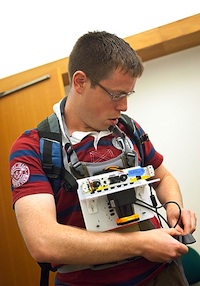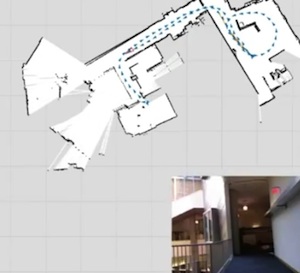MIT Auto-Sensing System Maps Emergency Sites
- By Dian Schaffhauser
- 09/26/12

Researcher Maurice Fallon walks around a building wearing the sensor system. |
Researchers at MIT have developed the prototype for a "wearable sensor system" that can create a digital map of an environment as the person wearing the system moves through the building. The team lead said the goal of the project was to develop a tool that could perform "situational awareness" in search and rescue operations. Developed by MIT's Computer Science and Artificial Intelligence Laboratory, the project was supported by the United States Air Force and the Office of Naval Research. The system is described in a paper that is intended to be presented in October during the "Intelligent Robots and Systems" conference in Portugal.
In experiments conducted at MIT's campus, a graduate student wore the sensor system on his chest while wandering the halls. As he moved around the building, sensors on the unit wirelessly relayed data to a laptop in a distant conference room. Viewers in the conference room were able to track his progress on a map that self-generated as the student moved.
The person wearing the sensor system can click a pushbutton to make "points of interest" annotations on the map. The researchers said this capability would allow an emergency responder to add voice or text tags to designate specific kinds of damage or danger.
The system includes a laser rangefinder, which runs a laser beam around a 270-degree arc and measures the time it takes for a light pulse to return. A cluster of accelerometers and gyroscopes, and a barometer enable the scientists to measure how fast the wearer walking and what floor he or she is on. A camera captures a snapshot of surroundings every few meters, and software culls visual features from the photos to associate with a location on the map.

The wearable sensor mapping process |
The prototype consists of a handful of devices attached to a sheet of hard plastic about the size of an iPad, which is worn on the chest like a backward backpack. Eventually, the researchers said, the system could be shrunk to the size of a coffee mug.
"The operational scenario that was envisioned for this was a hazmat situation where people are suited up with the full suit, and they go in and explore an environment," said lead author Maurice Fallon. "The current approach would be to textually summarize what they had seen afterward: 'I went into this room on the left, I saw this, I went into the next room,' and so on. We want to try to automate that."
Other researchers on the project included faculty and students from the Departments of Mechanical Engineering and Electrical Engineering and Computer Science.
About the Author
Dian Schaffhauser is a former senior contributing editor for 1105 Media's education publications THE Journal, Campus Technology and Spaces4Learning.